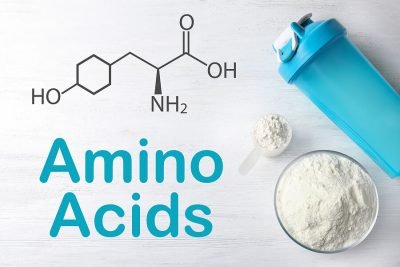Table of Contents
Amino acids are the unsung heroes of our body’s functions. Serving as the fundamental building blocks of proteins, they play crucial roles in almost every biological process. From muscle building to hormone regulation, understanding amino acids is key to optimising your health and well-being.
What Are Amino Acids?
Imagine amino acids as the alphabet’s letters. Just as letters combine to form words, amino acids join together in various sequences to create proteins. These proteins, in turn, perform diverse functions throughout the body. With thousands of different proteins, each having its unique sequence of amino acids, the possibilities are vast.
The Types of Amino Acids
Of the 20 amino acids our body needs, nine are deemed essential. This means our bodies can’t produce them, necessitating their intake through food. Let’s delve into these nine essential amino acids and their roles:
- Histidine: Essential for immune function, digestion, sleep, and sexual function, histidine is also a precursor to the brain chemical histamine.
- Isoleucine: Involved in muscle metabolism, immune function, and energy regulation, isoleucine also aids in hemoglobin production.
- Leucine: This amino acid promotes protein and growth hormone synthesis, muscle repair, wound healing, and blood sugar regulation.
- Lysine: Vital for hormone production, energy, calcium absorption, and immune function.
- Methionine: Assists in tissue growth, metabolism, detoxification, and the absorption of essential minerals like zinc and selenium.
- Phenylalanine: Needed for the production of brain chemicals like dopamine, epinephrine, and norepinephrine, and is also crucial for other amino acids’ production.
- Threonine: Plays roles in collagen, elastin, fat metabolism, immune function, and blood clotting.
- Tryptophan: Helps maintain nitrogen balance and aids in the production of serotonin, regulating mood, appetite, and sleep.
- Valine: Important for muscle growth, tissue regeneration, and energy production.
The remaining 11 amino acids are nonessential, meaning our bodies can synthesize them. However, under certain conditions like illness or stress, some nonessential amino acids become essential, earning the label “conditional.”
Amino Acid Structure
All amino acids share a basic structure consisting of a central carbon atom bonded to an amino group, a carboxylic acid group, a hydrogen atom, and a unique side-chain or R-group. This R-group determines the amino acid’s chemical properties, influencing its interactions with other amino acids and its environment. Peptide bonds link amino acids together to form proteins, which then fold into specific three-dimensional shapes based on the forces exerted by the amino acids and their R-groups.
The Functions of Amino Acids
Amino acids are indispensable for various bodily functions, including:
- Digestion: Breaking down food.
- Tissue Growth and Repair: Vital for skin, hair, nails, and muscle.
- Hormone and Neurotransmitter Production: Influencing mood, energy, and other physiological processes.
- Energy Source: Providing fuel for the body.
- Immune System Support: Boosting defenses against pathogens.
- Healthy Skin and Connective Tissue: Maintaining elasticity and structure.
- Muscle Building: Aiding in muscle growth and regeneration.
- Digestive System Maintenance: Ensuring normal digestion.
How Many Amino Acids Does the Body Need?
While you don’t need to consume amino acids at every meal, maintaining a balanced intake throughout the day is crucial. Here’s a breakdown of the recommended daily allowance for essential amino acids per 2.2 pounds of body weight:
- Histidine: 14 mg
- Isoleucine: 19 mg
- Leucine: 42 mg
- Lysine: 38 mg
- Methionine: 19 mg
- Phenylalanine: 33 mg
- Threonine: 20 mg
- Tryptophan: 5 mg
- Valine: 24 mg
Food Sources of Amino Acids
To meet your amino acid needs, consider incorporating these foods into your diet:
- Complete Proteins: These foods contain all nine essential amino acids. Examples include beef, poultry, fish, eggs, dairy, soy, quinoa, and buckwheat.
- Incomplete Proteins: While these foods don’t provide all essential amino acids, they are still valuable sources. Nuts, seeds, beans, and certain grains fall into this category. If you’re vegetarian or vegan, combining different incomplete proteins can ensure you get all essential amino acids.
Amino acids are vital for optimal health, playing roles in everything from muscle building to mood regulation. By understanding their types, structure, functions, and dietary sources, you can make informed choices to support your body’s needs. Whether you’re a meat-eater, vegetarian, or vegan, there are plenty of ways to incorporate amino acid-rich foods into your diet and enjoy the benefits they offer.
Remember, a balanced intake of amino acids is key to unlocking your body’s full potential and maintaining overall well-being. So, next time you sit down for a meal, consider the amino acids you’re consuming and how they contribute to your health.
for more health&fitness tips clickhere
